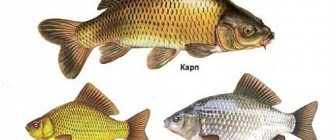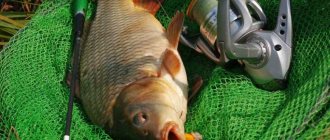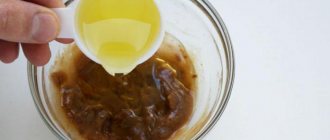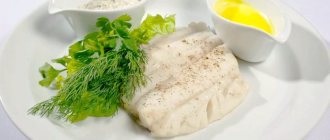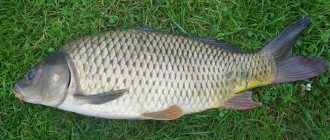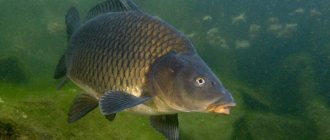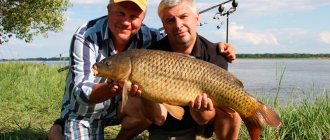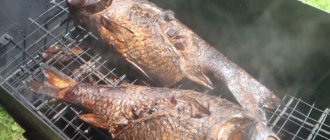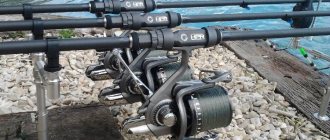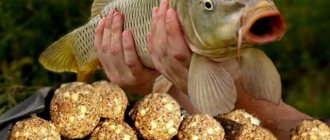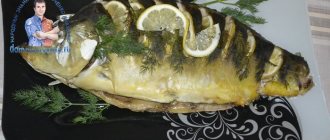Carp is a freshwater fish of the carp family of the order Cypriniformes. You can recognize it by its large, slightly elongated humpbacked body, golden scales with dark edges, large mouth and high-set eyes. You can distinguish carp from other fish belonging to the cyprinid family (these include crucian carp, grass carp, tench) by the presence of short antennae on the upper lip.
What fish belong to the carp family, where do they live and what are their habits?
How long do carp live?
The lifespan of carp depends on its habitat. Most representatives of this species are grown artificially, so their lifespan is limited to 2-3 years. It is at this age that the fish reaches marketable condition. Individuals living in their natural environment have a chance to live much longer. Thus, carp in a lake without regular industrial fishing, in a river or bay, may well live up to 30-35 years or more.
Experts do not recommend relying on its size when determining the age of caught fish, since the growth of carp over a season depends on many factors: water temperature, amount of food and diet. A more accurate method is to count sclerites (annual rings). To do this, you need to carefully separate a intact scale without damage, wash it and examine it with a magnifying glass in good lighting. Experienced fishermen, by the number and width of sclerites, determine not only how much the fish grows before being caught, but also the conditions in which the carp lived, how it fed and when it spawned.
Appearance and features
The carp began its journey along the ladder of civilization as a river carp. It was from his ancestor that he inherited:
- Massive torso;
- Large, geometrically correct head;
- A small hump at the junction of the head and body;
- Protruding eyes;
- Double nostrils;
- Retractable mouth with two antennae on the upper lip;
- Large scales covering no more than a quarter of the body surface.
They say that it was the large and shiny scales, which you can even look at, that gave rise to the name of this carp.
Note that the size and number of these fish body protectors is not a constant. There are a lot of options here, even in offspring from the same pair of parents.
Why is it called mirror or royal?
If you look closely at the appearance of the mirror carp, you will find that its largest scales are located near the gill covers. They sparkle so much with mother-of-pearl that you can see your reflection in them. This is precisely the reason for the name it bears today.
The “royal” status could be acquired due to the fact that for a long time this type was included in the dinner menu of exclusively high-ranking persons, such as kings, emperors and kings.
Sizes of mirror carp in different conditions
The impressive dimensions of the mirror inhabitant of the underwater kingdom are a consequence of its artificial origin. It is almost always larger than its direct ancestor, the carp. “Greenhouse” conditions, a stable food supply and the absence (in farm ponds) of enemies allow the mirror carp to grow to impressive dimensions.
We recommend reading: Catching chub on the river in winter
Today, the officially registered record is considered to be a specimen caught in 2015 in one of the ponds in Hungary. With a body length of 125 cm, the giant tipped the scales to 47 kg.
Domesticated carp sometimes (whether with malicious intent or good intentions) ended up in the wild, that is, in a river, wild pond or lake.
Here it is much more difficult for him to achieve records in weight and size for obvious reasons. That is why, in nine cases out of ten, fishermen already consider specimens weighing up to 20 kg with a body length from lips to tail of 60-70 cm as trophies.
Advantages of the Altai mirror carp breed
The high potential of domesticated carp as a food product has become the reason for a scientific approach to its selection. An example of this is the breeding of the Altai mirror carp.
Thanks to the experiments of ichthyologists and as a result of crossing the best individuals, a subspecies was born with:
- Wide back;
- A knocked down body;
- Good winter hardiness (up to 94-96%);
- Early sexual maturity (males - from 3 years, and females - from 4 years);
- Excellent fertility (up to 750-880 eggs from an adult female);
- High growth rate;
- A reduced amount of required feed per kg of weight gain (from 2.8 to 3.1 kg).
Thus, an optimal subspecies was obtained, which turned out to be attractive to both farmers and ordinary people.
Where is carp found, its habits
The structure of carp is practically no different from the structure of other cyprinids, but the way of life has certain features. The adaptation of carp to its habitat ensured the spread of the species on almost all continents of the globe in temperate and warm climate zones. You can meet one of the types of carp in rivers, lakes, reservoirs, flooded quarries, canals, sea bays at the confluence of rivers.
Favorite habitats: densely overgrown with algae creeks with a sandy or clay bottom, snags, thickets of coastal bushes. Carp are considered a heat-loving fish, so they prefer to stay at a depth of 2 to 5 meters in well-warmed water.
Fry and young animals gather in small flocks, while adults lead a more solitary lifestyle. Carp can form schools before the breeding season or in the fall before hibernation to collectively search for the most suitable places for spawning and wintering.
The body temperature of carp depends on the heating of the surrounding water; when the reservoir freezes, the vital processes of the fish slow down. It sinks to the bottom, lies in a secluded place and remains motionless for several days. In the winter months, the carp's body is covered with a thick layer of mucus; the fish finds a depression in the bottom, buries itself in sand and silt and remains in its shelter until the end of March and beginning of April.
Where does it live?
Since this species was bred artificially, it lives mainly in private reservoirs. It is the largest of the cyprinids and reproduces well. Therefore, many fish farms in our country are engaged in its breeding.
Carps also live in natural reservoirs. Mostly reservoirs are distributed in Europe and Asia, but the habitat is wide in Russia. It includes many regions of Russia from Kamchatka to the Baltic. Many regions have their own breed of this carp:
- Sarobyansky and Altai cold-resistant species are common in Kamchatka and Siberia;
- in the center of Russia and in the north the Central Russian and Chuvash species live;
- in the North Caucasus and the south of our country the Krasnodar and Stavropol species are found.
Cyprinids live only in fresh water bodies. These fish do not like fast currents. Under natural conditions they can live in lakes and rivers with very weak currents. They like clay bottoms to hibernate during the winter. Carp will not refuse to settle in shallow water with snags, holes, ledges and other places where you can reliably hide.
What does carp eat?
Carp are classified as unpretentious omnivorous fish. The diet may consist of mollusks, crayfish, worms, and leeches. The food is stems and young shoots of algae and reeds. A special feature of carp is that it is able to eat its own eggs and barely hatched fry.
In search of food, the carp sinks to the bottom and examines it, choosing everything that can be eaten. It crushes the harder parts of crustaceans, insects and mollusks with its lips and pharyngeal teeth.
In the industrial rearing of young animals, the diet consists of cereal crops, specialized feed, and dietary supplements that stimulate weight gain. In this regard, it is believed that fish grown in natural conditions has healthier and tastier meat.
Mirror carp is a domesticated freshwater fish, carp.
For a long time, humans have successfully domesticated not only land mammals, but also a variety of fish for use as food. An example is the freshwater fish mirror carp, which has long been the object of breeding and selection work to obtain new breeds of this fish. It is a domesticated carp and its most common breed. For example, in the 80-90s of the last century, commercial products of this particular carp accounted for 80 percent of the total volume of fish grown in Russian pond farms. Currently, it is grown not only at natural temperatures (in lakes and artificial ponds), but also in various warm-water farms. It was possible to expand its distribution area to the north into Western Siberia thanks to the bred cold-resistant form (Altai mirror carp).
When does carp spawn?
The breeding season begins at the end of April-May. The water should warm up to a comfortable +18-20 degrees. If the year began with a cold, long spring, carp may come to spawn even in June. Sexual maturity in males and females occurs at the age of 4-5 years. It is not for nothing that carp are considered a very prolific fish: the eggs laid by one female in a season can contain up to a million eggs.
Cyprinids spawn in shallow water in thickets of reeds or algae. The eggs are laid in portions over several days and are fertilized by several males at once. Under favorable conditions, the fry appear on the fifth or sixth day. At first, they get everything they need for growth from the yolk sac, and then they switch to zooplankton.
Carp, carp and crucian carp
Carp, carp and crucian carp are species of fish of the carp family, order Cyprinidae. They differ in body structure, lifestyle and habits. However, all cyprinids have the same structure of internal organs. The fish has a lower mouth, so it is characterized by a bottom feeding method. There are 2 varieties of carp: river and pond. River carp is called carp (the ancestor of all species and breeds), and pond carp is a cultivated river fish. One of the main features of all carp is 2 antennae near the upper lip. The differences between the given forms of fish are that pond carp are taller and thicker. However, river species are characterized by rapid growth and great cunning.
To better understand what the difference is between carp and carp, just look at the body shape: river fish have a more elongated and streamlined body, while pond fish are round, have darker scales, and also have a hump between the back and head. In recent years, there has been a decline in the number of carp, and it is rare to find it in a fisherman’s catch. Basically, carp weighs about 5-6 kg, life expectancy is 30-35 years.
There is also a great similarity between carp and crucian carp, but crucian carp has the following distinctive features:
- lack of mustache;
- the body is strongly compressed laterally, high and elastic;
- lighter, smaller and tougher scales;
- smooth outline of the dorsal fin.
It is worth noting that there is crucian carp that lives in the sea. However, it belongs to the order Perciformes, not Cyprinidae. Basically, domesticated carp are distinguished by how the fish looks, i.e. by color and number of scales:
Each variety of carp has its own characteristic body structure. There are subspecies that resemble the body shape of silver crucian carp, and there are, on the contrary, with an elongated body.
Fishing Features
Large carp are an enviable trophy even for very experienced carp anglers. It is not so easy to catch it, because it is a rather cautious, cunning and unpredictable fish. However, with the right choice of fishing location, gear, groundbait and bait, you can count on catching truly impressive specimens. It is known that the largest carp caught in Russia on a fishing rod weighed 48 kg.
What you need to know about carp fishing?
Carp, sensitive to low temperatures, hibernate in the winter months; the optimal time for fishing for cyprinids is considered to be from late spring to early autumn. Fishing can begin 10-14 days after the start of spawning. Spawned fish are less wary due to hunger, increasing the likelihood of a catch.
During the warm season, carp are active in the early morning and evening. If you watch a pond after sunrise in calm weather, you can determine the carp’s habitat: it splashes and jumps out of the water, raising a fountain of spray. Since cyprinids are not prone to migration, determining where to fish will increase the chances of success.
To catch carp, a feeder, donka or float rod is usually used. The bait can be of plant (corn, peas) or animal (worms, bloodworms, maggots) origin. Before throwing bait, be sure to feed the area. As a bait mixture, you can use corn, pearl barley, and peas soaked for 12 hours. To attract fish, it is recommended to add a flavoring that smells like garlic, caramel or vanilla.
In most cases, pulling caught fish ashore is not easy, since landing is complicated by aquatic vegetation. Experienced fishermen recommend gradually pulling the carp towards the shore, allowing it to move in a circle.
Habits and food supply
Mirror carp are considered a schooling fish. Up to a certain age and size, they prefer to live in groups of 5-10 individuals. However, large specimens over 5 kg often try to live in solitude. They gain weight quickly. Already a one-year-old carp weighs about 1 kg. After three years, the fry of this fish reaches a weight of 3 kg and a body length of 50-60 cm.
Mirror carp spend the cold season in a sleeping or half-asleep state at depth. His awakening begins in March-April. Spawning occurs in May-June, when the water temperature reaches 15-18 °C. By the way, this fish reaches sexual maturity only at 3-5 years of life.
Fishing for mirror carp begins in May. At this time, in almost all reservoirs the water warms up to 10 °C. The last fishing season is in October-November.
Mainly mirror carp feed on bottom vegetation, young shoots of reeds, eggs of frogs and fish, insects, mollusks and other organisms. If the reservoir is used for breeding fish and organizing fishing, then the food base is compound feed, cereals, grain waste, cake, etc. However, despite the large list of what carp absorb as food, it can be extremely difficult to choose what to fish with.
It is almost impossible to guess what baits mirror carp will like today. His diet may differ significantly from yesterday's taste preferences. Therefore, experienced carp fishermen use a wide variety of baits (including quite exotic ones - cucumber, cheese, berries, etc.):
- worm;
- maggot;
- bloodworm;
- corn;
- pellets;
- boilies;
- dough;
- potato;
- peas and more etc.
The nutritional value
Carp meat has excellent taste characteristics: it has a pleasant sweetish taste, tender and juicy. In addition, fish is valued due to the low calorie content of dishes prepared from it and its rich biochemical composition. The nutritional value of carp is provided by Omega-3 and Omega-6 polyunsaturated fatty acids, phosphorus, iron, calcium, iodine, B vitamins, as well as A, C, PP, which are part of the meat.
Like other carp-like fish, carps have a fairly large number of small bones in their meat, which should be taken into account when preparing dishes. Carp is suitable for baking (both in foil and on the grill), frying and stewing. Cutlets, meatballs and meatballs are prepared from fish fillets.
Fishing club Fishing at Ivanovich (Big Stallions)
The fishing club Fishing at Ivanovich is located just 15 km from Moscow in the Shchelkovsky district in the village of Bolshiye Zherebtsy. Getting to the fishing spot is very easy by any car along an asphalt road. The reservoirs are located in a picturesque place, the water in them is clear and clean, the shore is tidy and equipped for comfortable fishing and a pleasant time with family or friends.
Paid fishing at the fishing club is organized on two ponds - Bolshoi and Maloy. The depth of reservoirs is on average up to 3 meters. The perimeter of the shore is equipped, with convenient access anywhere. The bottom is clean, there is practically no aquatic vegetation. Currants, raspberries, thujas and decorative Christmas trees are planted along the pond; the lawn is always well-groomed with paved paths.
Fishing conditions on paid ponds of the fishing club are somewhat different from the usual conditions that are practiced on most reservoirs in the Moscow region. The cost of the tour is insignificant and amounts to only 300 rubles. However, the fisherman does not have the right to release the caught fish. After fishing, all fish are weighed and paid according to the prices established by the club. This approach allows the fisherman to plan the duration of fishing depending on the activity of the fish and stop in time when a sufficient number is caught.
In the paid ponds of the fishing club Fishing at Ivanovich there are carp, mirror carp, trout, sturgeon, ornamental koi carp, pike, grass carp, tilapia, crucian carp and channel catfish. Reservoirs are periodically stocked with fish, so the fish population is always large and it actively bites on the bait offered, the best of which are worms, corn, maggots and dough. The most common fishing methods here are a float rod, a feeder and a spinning rod, and in winter a jig, a float and a spinner.
On the territory of the fishing club, cozy gazebos have been built that can accommodate different numbers of visitors. Small companies will be quite comfortable in 6- and 10-seat gazebos, and for a large company there is a gazebo that can accommodate up to 25 people. Near each gazebo there is a grill for preparing barbecue.
- Location: Fishing club Fishing near Ivanych is located in the village of Bolshie Zherebtsy, Shchelkovsky district, Moscow region
- Directions: You can get to the fishing club Fishing at Ivanych along Shchelkovskoye Highway. Having reached Bear Lakes, turn right
- Nozzle, bait: corn, maggot, bread, worm
- Types of fish: White Amur, Crucian carp, Carp, Sturgeon, Carp, Whitefish, Catfish, Trout, Pike
- Price: 300 rub. per person without the right to release caught fish, which is paid separately
- Contact information: Tel.: 8-926-926-78-87, 8-926-911-94-07; Website: 9267887.ru
Source: fish.rybalkanasha.ru
Origin
There is a firmly rooted theory-myth that a fish such as carp is not the original, nature-created inhabitant of low-current and stagnant freshwater bodies of water. Allegedly, it owes its appearance to the painstaking selection work associated with the domestication of wild river carp, whose ancestral home is the south of China and the Caspian Sea. This is fundamentally wrong. Wild carp have always had river and lake varieties, which differed in body shape. The fish, which constantly lives in oxygen-rich rapids, had a low torpedo-shaped body and stretched out in length. The same carps, whose habitat was in calm and food-rich water bodies with a minimum of large predators, quickly gained weight, became fat and grew upward.
It was the lake variety, which historically was accustomed to living in conditions of oxygen deficiency, without any selection changes, that was introduced by humans into many water bodies in Europe, Asia, and North America. The issue of biological species improvements on an industry scale arose only in the last 150-200 years and led to the emergence of dozens of original breeds and hybrids.
It is important to know that the term “carp” has no scientific basis and was formed in the 19th century with the light hand of the famous author of books on fishing and hunting, Sergei Aksakov. The Ufa writer often visited his small homeland, where he took part in multi-day outings into nature. During one of his trips to the largest tributary of the Kama - the Agidel River (Belaya River), he had the opportunity to catch wild carp. The local guide, a Bashkir, called them sazans, which translated from Turkic means “silt fish.” After the author’s publications, the easy-to-remember word took root among the people, but from the point of view of ichthyology, wild and domestic carp are one species (Cyprinus carpio).
The lake form is widespread, valuable and commercially available; it is the basic representative of the genus called common carp. Other designations are also officially used for the taxon: typical, golden, scaly. Often in everyday life there is a name borrowed from the Old Church Slavonic language - korop.
What does carp look like?
The carp's body grows wider.
Tips for fisherman: What gear is needed for carp fishing - Features of choice
Carp, the most commonly found in Russian reservoirs, can be divided into 3 types based on appearance:
Common carp (scaly)
This fish is evenly covered with dense scales, the color of which can vary from brown to golden in different habitats.
The scaly carp reaches the largest size among its fellows.
Mirror carp
It is very different from ordinary carp. Its body is almost naked, with sparse large scales. It can be located along the lateral line or in islands, leaving most of the body unprotected. Large individuals may have a large belly due to the lack of hard scales. They are less common than scaly carp and reach smaller sizes.
Naked leather carp
Very rare. The body is practically naked. Rare scales may be located near the tail and gills. The smallest and most unadapted to life among carps.
As for the carp, it is a distant relative of the previous specimen. If you don’t look closely, they can be quite easily confused, however, the former are domesticated breeds, and the latter are wild . On the body of any carp there is a scaly layer, and it can only grow in length, but not in width, unlike carp .
Service and entertainment
- On the territory of the base there is a wonderful Russian bathhouse, where you can fully relax after a busy week of work. It provides all the amenities with thoughtful interior design;
- There are also sports grounds where you can gather your team and have fun playing football, volleyball or basketball. And if you come without your friends, you can always find friendly people who will be happy to play with you;
- In winter, you won’t be bored either, because there is a winter skating rink. What can be as enjoyable as an active pastime on ice skating?
- For those who do not have the necessary equipment, be it skates, soccer balls or other equipment, there is a rental point for sports equipment. So don’t be discouraged if you couldn’t find some important equipment before leaving, here you can always rent everything you need;
- If you want to find out the most fishing spots, or if you, as a hunter, are interested in exploring the area and noting yourself where you can most often find game, then it is at the base that tours are organized for these purposes. They will always meet you halfway and clearly explain all the topics that interest you;
- If you are a fisherman, but unfortunately, while relaxing at the base, you broke or lost your equipment, and you cannot live a day without fishing, do not despair, gear rental is open especially for such situations;
- The base has an open area for playing paintball - this is an exciting team game that will test your shooting skills, as well as your reaction speed. You can rent the entire area for full price and enjoy relaxing in the gazebo and barbecuing on the grill in the intervals between shooting;
- Banana ride on the lake. If you crave new impressions from a good rest, then choose this type of service and experience the feeling when it is difficult to hold on when entering a turn on a banana when it passes through the waves. A slow walk on the surface of the water is also possible;
- The Blob is a large inflatable catapult that will make you jump very high and then land in the water. The record set on it is 7 meters;
- Tubing is a large springboard slide, going down which you will experience breathtaking feelings;
- It is also possible to rent bicycles for cycling in the surrounding area;
- Ski trips with a special guide, skis are rented if you don’t have them.
How much does it cost to stay at a camp site?
- Renting a house will cost you from 4,000 to 25,000 rubles per day, it all depends on the size and the number of places equipped in the cottages;
- A Russian wood-burning sauna will cost from 750 to 2000 rubles per day;
- A day on the beach costs 200 rubles;
- Winter fishing - 500 rubles, summer - 1000 rubles;
- Paintball from 500 to 1500 rubles, it all depends on the amount of equipment received and various amenities;
- Banana ride – 250 rubles per hour ride;
- Sports grounds are rented for 100 rubles per hour, all necessary equipment can be provided;
How to get there (routes)
There are two shuttle buses running to the Mirror Carp base, which will provide you with convenience with your schedule.
Route No. 111 departs from the stop “at 08.30 and 17.50;
Route No. 311 departs from the southern bus station every hour.
Work period
This base operates year-round. At different times of the year, various entertainment venues operate on its territory. For example, in the summer, various water attractions are available, and in the winter, an ice skating rink is open.
Contacts
Email: ;
Telephone:, +7 (917) 47-99-999
